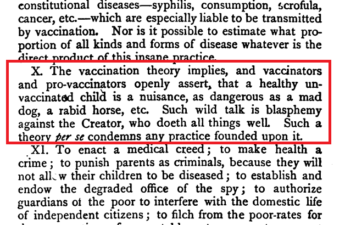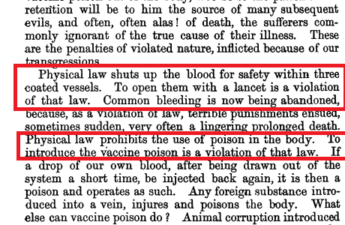
by Steve Halbrook
I sought the Lord, and he answered me
and delivered me from all my fears. (Psalm 34:4, ESV)
In an age of irrational fear of contagion — that leads so many to their deaths as they flee to vaccination as a supposed preventative — it is important to note that many conditions and diseases that were once said to be contagious are no longer so. The hubris of many pro-vaxxers — as if they have contagion all figured out — has no bounds.
There was even a time when epilepsy was thought to be contagious:
The popular belief that epilepsy is contagious, dates to antiquity when people used to spit at a person with the condition and refused to use the same dish. … Berthold of Regensburg, a 13th century German preacher, wrote of the contagious character of the infection carried by the patient’s “evil” breath. In the 15th century a professor wrote: “Therefore, neither talk nor bathe with him, since by their mere breath they infect people”. In the 18th century, epilepsy was still believed to be infectious.
The History and Stigma of Epilepsy, Epilepsia, 44 (Suppl. 6) (Blackwell Publishing, Inc., 2003), 12. Retrieved January 18, 2024, from https://onlinelibrary.wiley.com/doi/pdf/10.1046/j.1528-1157.44.s.6.2.x
Quite often, the culprit in disease is nutritional deficiencies. This is important to understand, as nutrition — not vaccination — is crucial to a healthy immune system. Whether there is an actual contagion, an environmental poison, or a nutritional deficiency, the better your nutrition, the better (Lord willing) your potential for dealing with it.
And so you cannot rely on “popular medical opinion,” but must do your own research. “Popular medical opinion,” as is very obvious today with the COVID scamdemic, can get you killed.
As a journal in 1875 states,
But popular opinion does not necessarily go far in settling questions of contagion, nor is the opinion of medical men decisive, when we recollect that scurvy was considered both contagious and hereditary, that at one time no one would venture to dispute the fact, and that formerly it was believed that syphilis was communicable by the air.
The British and Foreign Medico-chirurgical Review Or Quarterly Journal of Practical Medicine and Surgery, Volume 55, January-April, 1875 (London: J&A Churchill), 308.
Besides scurvy (a deficiency in vitamin C), some nutritional deficiencies once thought to be infectious diseases include beriberi (a deficiency in thiamine, or vitamin B1), pellagra (a deficiency in niacin, or vitamin B3), and rickets (a deficiency in vitamin D).
Good nutrition strengthens the immune system. Thus it can protect you from disease directly and indirectly: both from diseases of nutritional deficiencies and other kinds of diseases that result from an impaired immune system due to malnutrition.
And so infectious disease (or at least what is thought to be so) and nutritional deficiency tend to go hand-in-hand.
The modern science of nutrition grew out of efforts to understand and isolate the dietary factors promoting health and preventing disease. Finding the causes of vitamin deficiency diseases was no simpler than unraveling the etiology of infectious diseases; indeed, both kinds of disorders often appeared in the form of devastating plagues and pestilences.
Lois N. Magner, A History of Medicine (New York, NY: Marcel Dekker, Inc., 1992), 231.
Indeed, nutritional deficiency does not just take on a solo character, but a group one: families, communities, and nations. Thus one can easily misdiagnose a nutritional deficiency as a contagion. For instance, scurvy:
Scurvy, occurring in the military service, usually at once assumes an epidemic character, through the fact that large numbers of men are generally at the same time exposed to the conditions to which the disease owes its origin. From this fact, scurvy was long thought to be contagious. The disease has great respect for military rank and rarely occurs in officers; a fact due to their better nutrition and lessened exposure to depressing conditions. It has a marked tendency to occur in convalescents, and may frequently be associated with other diseases, to whose attacks it imparts additional severity. In the Crimean War, typhus which had occurred in a scorbutic patient was said to have been uniformly fatal. Winter is particularly the season when scorbutic manifestations appear; this being the season when fresh vegetable material is scarce and troops are largely confined, through the inclemency of the weather, in the vitiated air of their quarters.
Edward Lyman Munson, The Theory and Practice of Military Hygiene (London: Bailliere, Tindall & Cox, 1902), 762.
One need not look weak or emaciated to suffer from debilitating effects of poor nutrition. This is important, as Americans simultaneously suffer from obesity and an unhealthy diet — high calorie malnutrition. And so we Americans cannot automatically assume any given illness is anything (such as contagions) but a nutritional deficiency. As The 1871 book On the Wasting Diseases of Infants and Children states:
It is extremely important to detect the earliest symptoms of defective nutrition. Wasting is not always one of the first signs, and may even be altogether absent if the interference with nutrition is not carried to a high degree. Thus, a child may be exceedingly plump, and even excite admiration by his good condition, although he may at the same time be suffering from the insidious commencement of rickets, which, if the causes producing the disease continue unchecked, will shortly assert itself unmistakably.
Eustace Smith, On the Wasting Diseases of Infants and Children (Philadelphia, PA: Henry C. Lea, 1871), 18.
Imagine the health benefits if we focused more on nutrition than fear — the fear of germs.
If you find this site helpful, please consider supporting our work.


